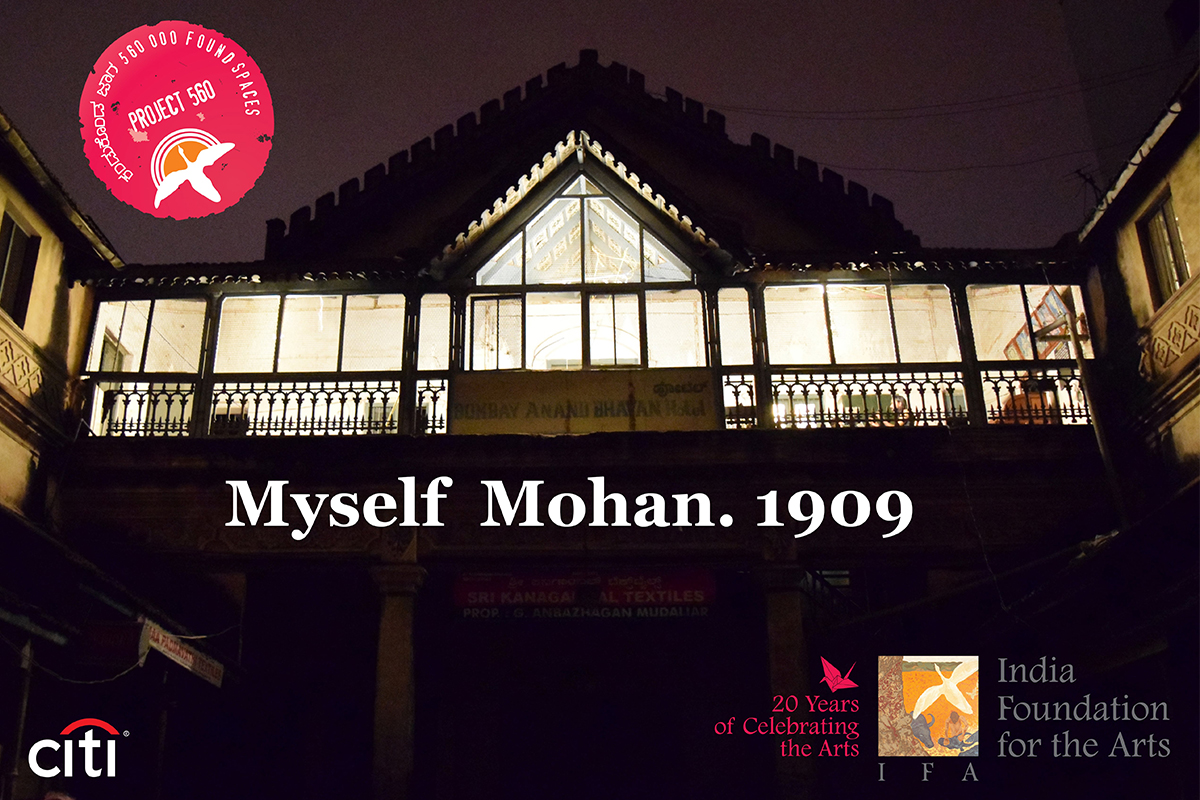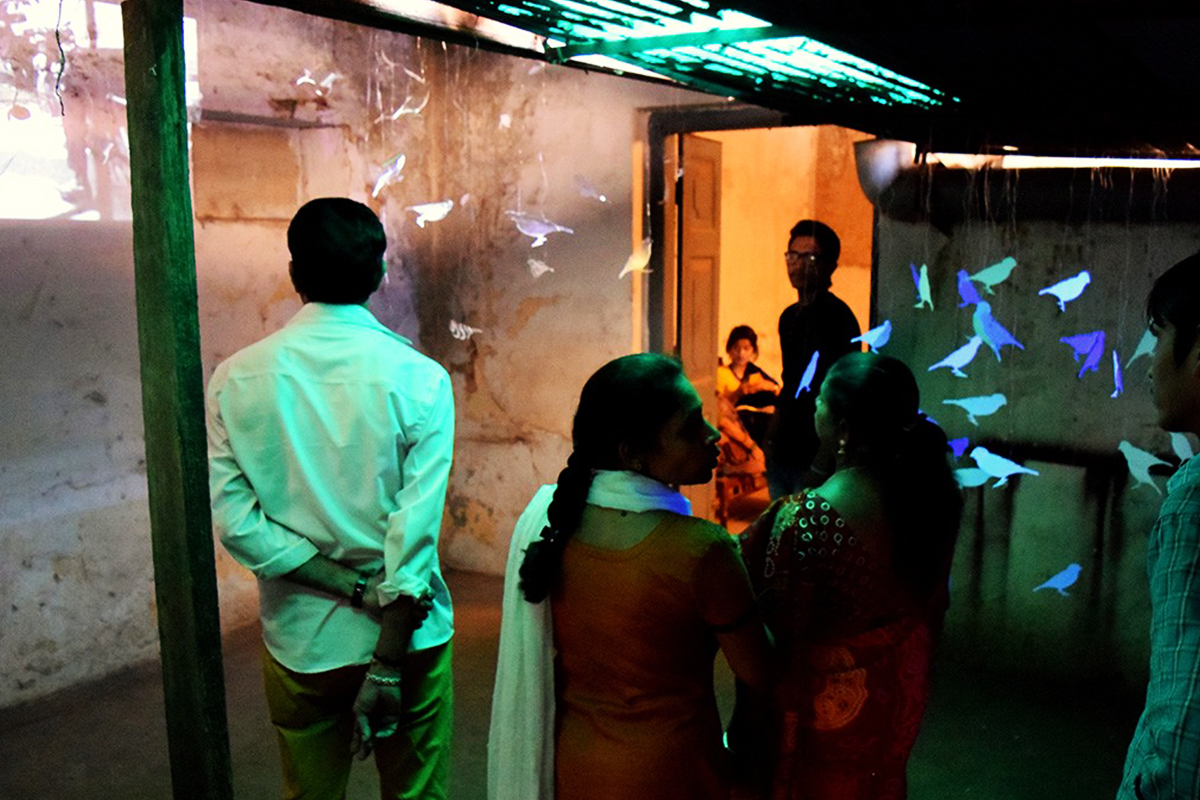
Myself Mohan. 1909
AN INTRODUCTION
Bengaluru is a city rich with layers of found spaces, scents, textures, and hidden corners—pockets of quiet history and vibrant life. While the city’s residents are often swept along by its fast pace, it can be easy to overlook the silent echoes of its past in muted alleys, fragrant roads, and fading lakes. The Bangalorean, chasing modernity, has gradually distanced herself from the city’s natural essence, leaving its air, trees, and water to bear the imprint of progress. As we delved into Bengaluru’s history, we stumbled upon a forgotten corner in Chickpet—a place where the richness of Bengaluru's heritage breathes quietly beneath the dust. Immersed in its abandoned rooms and colonial doors, we glimpsed a past brimming with life, vibrancy, and untold stories. This overlooked architecture speaks of the city’s cultural soul, a living relic of Bengaluru’s enduring identity.
About Klatsch Collective
Klatsch is a collective of artists, designers, and innovators, dedicated to public engagement through creative expression. Evolving from a small group of performers into a thriving community of over a hundred creators from diverse backgrounds, Klatsch operates from Cobalt BLR on Church Street, with a strong online presence via their Facebook group Klatsch Kafe. Prioritizing interactivity and inclusivity, Klatsch brings art to the public through dynamic, immersive experiences.
Our Mission
Spaces are layered with human emotion, histories, and stories—especially public spaces, which capture an interplay of personal and communal narratives. Bengaluru, a city of contrasts, is a vivid collage of memories, sensations, and evolving identities. This ever-changing landscape offers a mosaic of the visual, auditory, and tactile, some of which remain, some evolve, and some disappear with time. Through our work, Klatsch seeks to reveal these urban layers and invite the public to reconnect with Bengaluru’s storied landscape.

Through Project 560, Klatsch endeavours to capture all of this and more. The project attempts to bring to life (virtually) snippets of a few Bangaloreans transiently based at the Mohan Building in Chickpet. Creating a timeline of fictional and factual histories, the endeavour is to reconnect present-day Bangaloreans, and people who may have recently made Bangalore their home, with the city’s lesser-known, un-glorified past. Klatsch aspires to uncover the hidden identities of Bangalore and hear out the unheard, the mundane, and the forgotten.
The built heritage of the city has been a bystander to numerous life histories, it has played host to celebrations galore and has painfully witnessed a few catastrophes too. Through Klatsch this built heritage comes alive, it becomes the Protagonist and not a mere onlooker. What happens when the Mohan building is treated as the living; the breathing? What happens when the building starts to narrate stories and incidents? Stories of labourers who built the place, of the old lady who sat quietly through a panchayat session, stories of the common man who spent a night at the Bombay Anand Bhavan Ashram?
These everyday stories are what we are looking to narrate, taking the Mohan Building as a constant, and the people around as the mobile, transitory passersby. The project looks to convert this found space into a heterogeneous mix of spatial artworks, which act directly on the physical spaces present within the Mohan Building. Transforming the internal spaces into active, significant elements, able to transmit emotions and tell stories contextually located within the structure.





THE CHOSEN SPACE: Built in 1909, the Mohan Building has had a multitude of functions to play. Sometimes called Bangalore’s first commercial mall, the building started out as a Taluka Kacheri when it was constructed. Viewing galleries around the main courtyard, as well as the main hall on the first floor, makes it easy to imagine heated discussions taking place in the space below. Around this time the building also housed a police station inside its walls. After the Kacheri was shifted, the building took on a commercial hue with cotton and silk shops occupying the rooms around the courtyard. Some of these shops still exist today and are being evicted by the building’s new owners. This combination of colourful shops inside the courtyard and food stalls just outside the compound wall has earned the building the tag of ‘Bangalore’s first mall’.
About 45 years after the building was constructed the first floor area was taken up by the Bombay Anand Bhavan Hotel. Climbing up the staircase into the reception area of the hotel throws you into a space brimming with stories, stuck in time. Well-preserved artefacts, like a numbered key holder at the reception and a board asking guests to dutifully pay their dues, still adorn the walls of the space. Walking through the main functioning areas of the hotel, it’s easy to see that the rooms were retrofitted into the big halls, one of the many transformations Mohan Building has seen.
OUTCOMES: We seek inspiration from spaces that we see around us, sounds that we hear and the people who aspire to surround us with their complex simplicities. When the aforementioned are picked proportionately and woven together with hints of imagination and creative flare, a beautiful tale resounds. We are here to capture that tale and present it to the people of Bangalore in three ways:
A. Ephemeral Spatial works: Using the already existing, fast dilapidating space of the Bombay Anand Bhavan aka Mohan Building; Klatsch will look at reimagining and trying to recreate certain experiences of a bygone era in cohesion with the historical representation and recollection of the former glory of this iconic establishment. This would be in terms of Reconstructing a life story from the era that saw the construction of this architectural masterpiece, representative of the colonial period (1909).An artistic representation of a fictional scenario of the Taluka Kacheri (panchayat) with live performances and audiovisual installations.A spatial Illustration characterizing a narrative taken from the official records of the Police station that was once housed in the Mohan building.
Reimagining and renovating the lodging space to recreate an atmosphere of relevance to the perceived inhabitants and functioning of the Bombay Anand Bhavan Ashram.
Collaborating with local traders in and around the vicinity of the building, engaging and ideating with them to recreate certain scenarios from the time of their forefathers who came to Bangalore and set up shop generations before.Collaborating with the local food and chai walls in the vicinity and helping them set up shop in the compound of the Mohan building during the exhibition to engage the audience with an overall experience and give them a true feeling of stepping back in time.
B. Documentation: We wish to inculcate different documentation and communication mediums to share our work and experience with our audience as well as the general public of the digitalized world. We aimed to establish 5 different storylines based on the 5 spatial establishments of the Mohan Building in its many avatars over the years. These stories will be brought to life by performances, projection, and audio mapping which will be visually documented and edited into a multimedia deliverable that was published.
C. Community Activation: Through this project, we aspire to work with the local community who have been trading their goods for generations in the same space. We will collaborate with them for the research and implementation process. We hope to bring this older part of the city back into the limelight and create curiosity about this fascinating locality amongst the new Bangaloreans. This would also be a great opportunity for the local traders and shop owners to captivate the influx of people who visit the exhibition and interest them in their items of trade.



ACKNOWLEDGEMENTS and CREDITS
SPECIAL THANKS: Indian Foundation for the Arts (IFA), Project 560, Rajesh Exports, Kena, and Deccan Herald.
Klatsch Collective:
Akshaya Narsimhan | Arvind Prasad | Divya Ramachandran | Jeffrey Butts Jr. | Koyal Chengappa | Kyzeen Lala | Leona D’souza | Prithivi Raj | Rahul Gudipudi | Rahul KP | Rucha Dhayarkar | Saranya Gopinath | Shashank Satish | Shaunak Mahbubani | Ullas Hydoor | Vineet Kumar | Vishnu Kumar.
[Shashank Satish] Role played in the project:
Engaged in making public art accessible to the local community through active engagement.
Personally involved in the collective from applying for the grant, and group discussions on conceptualization, ideation, iteration, sourcing, and curation to the execution of installations on the ground.
Content creation: Posters, Graphics for social media, 3D modelling of the space for print material and handouts. Photographic documentation of the project.
Image Gallery Below: Photographs of the 3-day 'IFA Project 560' public art event in December 2015 at Mohan Building, Chickpete, Bengaluru.





